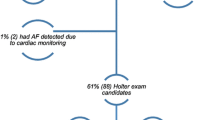Abstract
Aim
New technologic tools for continuous ECG monitoring have been developed to detect and treat atrial fibrillation (AF) in specific populations with high cardiovascular risk. We evaluated the prevalence and the management of AF diagnosed in patients with high cardiovascular risk and non-documented clinical palpitation undergoing systematic 14-day continuous ECG–Holter monitoring.
Methods
Patients were prospectively enrolled from December 2019 to December 2021 in this multicentre study, sponsored by the French National College of Cardiology. Patients met the following criteria: CHA2DS2VASc score ≥ 2 in males and ≥ 3 in females and clinical palpitations without previously documented arrhythmia. Enrolled patients underwent a continuous 14-day Holter–ECG monitoring for arrhythmia detection.
Results
Among the 336 included patients, 39% were male, 75% were greater than 65 years of age and 46.5% had suffered a prior stroke. AF was detected in 14% of patients, among which 23.4% were detected in the first 24 h of monitoring. Finally, age ≥ 65 years (p = 0.037) was significantly associated with AF, as well as male gender (p = 0.023) and a lower rate of antiplatelet therapy (p = 0.018). Patients with diagnosed AF had a prescription of anticoagulation therapy in 90%. Antiarrhythmic drugs were administered in 90% of AF patients and 13% underwent AF ablation.
Conclusions
The systematic AF screening of patients with palpitations and high cardiovascular risk resulted in a diagnostic yield of AF in 14% of the population with a 14-day continuous ECG–Holter monitor. This strategy resulted in the prescription of anticoagulation and antiarrhythmic therapy in 90% of the AF detected population.
Graphical abstract



Similar content being viewed by others
Abbreviations
- AF:
-
Atrial fibrillation
- ICD:
-
Implantable cardioverter–defibrillator
- ILR:
-
Implantable loop recorder
- PM:
-
Pace-maker
- SVT:
-
Supraventricular tachycardia
- VT:
-
Ventricular tachycardia
References
Krijthe BP, Kunst A, Benjamin EJ et al (2013) Projections on the number of individuals with atrial fibrillation in the European Union, from 2000 to 2060. Eur Heart J 34:2746–2751. https://doi.org/10.1093/eurheartj/eht280
Hindricks G, Potpara T, Dagres N et al (2021) 2020 ESC Guidelines for the diagnosis and management of atrial fibrillation developed in collaboration with the European Association for Cardio-Thoracic Surgery (EACTS): The Task Force for the diagnosis and management of atrial fibrillation of the European Society of Cardiology (ESC) Developed with the special contribution of the European Heart Rhythm Association (EHRA) of the ESC. Eur Heart J 42:373–498. https://doi.org/10.1093/eurheartj/ehaa612
Perez MV, Mahaffey KW, Hedlin H et al (2019) Apple Heart Study Investigators. Large-Scale Assessment of a Smartwatch to Identify Atrial Fibrillation. N Engl J Med 381:1909–1917. https://doi.org/10.1016/j.ahj.2018.09.002
Guo Y, Wang H, Zhang H et al (2019) Mobile photoplethysmographic technology to detect atrial fibrillation. J Am Coll Cardiol 74:2365–2375. https://doi.org/10.1016/j.jacc.2019.08.019
Glikson M, Nielsen JC, Kronborg MB et al (2022) 2021 ESC Guidelines on cardiac pacing and cardiac resynchronization therapy. Europace 24:71–164. https://doi.org/10.1093/europace/euab232
Jabaudon D, Sztajzel J, Sievert K, Landis T, Sztajzel R (2004) Usefulness of ambulatory 7-day ECG monitoring for the detection of atrial fibrillation and flutter after acute stroke and transient ischemic attack. Stroke 35:1647–1651. https://doi.org/10.1161/01.STR.0000131269.69502.d9
Sanna T, Diener HC, Passman RS et al (2014) Cryptogenic stroke and underlying atrial fibrillation. N Engl J Med 370:2478–2486. https://doi.org/10.1056/NEJMoa1313600
Svennberg E, Tjong F, Goette A et al (2022) How to use digital devices to detect and manage arrhythmias: an EHRA practical guide. Europace. https://doi.org/10.1093/europace/euac038
Healey JS, Connolly SJ, Gold MR et al (2012) Subclinical atrial fibrillation and the risk of stroke. N Engl J Med 366:120–129. https://doi.org/10.1056/NEJMoa1105575
Glotzer TV, Daoud EG, Wyse DG et al (2009) The relationship between daily atrial tachyarrhythmia burden from implantable device diagnostics and stroke risk: the TRENDS study. Circ Arrhythm Electrophysiol 2:474–480. https://doi.org/10.1161/CIRCEP.109.849638
Capucci A, Santini M, Padeletti L et al (2005) Monitored atrial fibrillation duration predicts arterial embolic events in patients suffering from bradycardia and atrial fibrillation implanted with antitachycardia pacemakers. J Am Coll Cardiol 46:1913–1920. https://doi.org/10.1016/j.jacc.2005.07.044
Hart RG, Sharma M, Mundl H et al (2018) Rivaroxaban for Stroke Prevention after Embolic Stroke of Undetermined Source. N Engl J Med 378:2191–2201. https://doi.org/10.1056/NEJMoa1802686
Diener HC, Sacco RL, Easton JD et al (2019) Dabigatran for prevention of stroke after embolic stroke of undetermined source. N Engl J Med 380:1906–1917. https://doi.org/10.1056/NEJMoa1813959
Svendsen JH, Diederichsen SZ, Højberg S et al (2021) Implantable loop recorder detection of atrial fibrillation to prevent stroke (The LOOP Study): a randomised controlled trial. Lancet 398:1507–1516. https://doi.org/10.1016/S0140-6736(21)01698-6
Funding
This study was supported by a grant from BMS-Pfizer company.
Author information
Authors and Affiliations
Corresponding author
Ethics declarations
Conflict of interest
All the authors declare no conflict of interest for this study.
Rights and permissions
Springer Nature or its licensor holds exclusive rights to this article under a publishing agreement with the author(s) or other rightsholder(s); author self-archiving of the accepted manuscript version of this article is solely governed by the terms of such publishing agreement and applicable law.
About this article
Cite this article
Halimi, F., Sabouret, P., Huberman, J.P. et al. Atrial fibrillation detection with long-term continuous Holter ECG recording in patients with high cardiovascular risk and clinical palpitations: the prospective after study. Clin Res Cardiol 112, 807–814 (2023). https://doi.org/10.1007/s00392-022-02109-9
Received:
Accepted:
Published:
Issue Date:
DOI: https://doi.org/10.1007/s00392-022-02109-9




